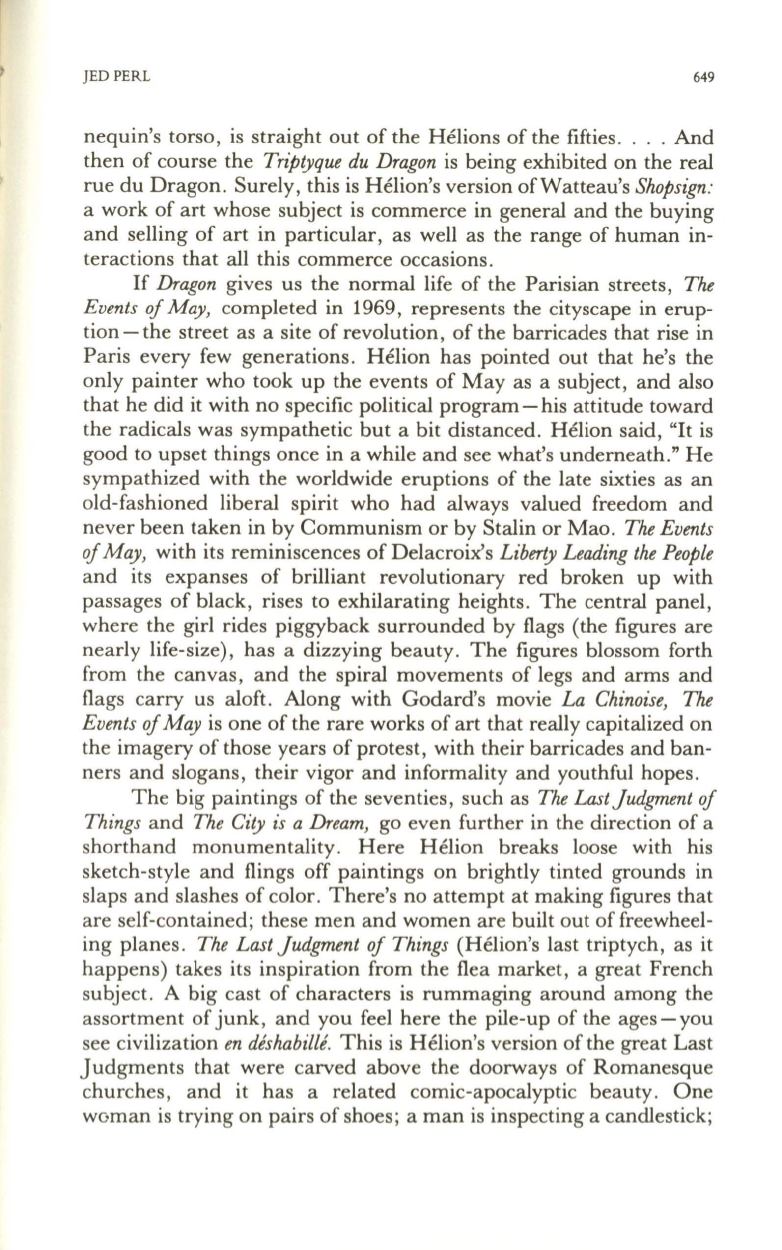
JED PERL
649
nequin's torso , is straight out of the Helions of the fifties . . . . And
then of course the
Triptyque du Dragon
is being exhibited on the real
rue du Dragon. Surely, this is Helion's version ofWatteau's
Shopsign:
a work of art whose subject is commerce in general and the buying
and selling of art in particular, as well as the range of human in–
teractions that all this commerce occasions .
If
Dragon
gives us the normal life of the Parisian streets,
The
Events of May,
completed in 1969, represents the cityscape in erup–
tion - the street as a site of revolution , of the barricades that rise in
Paris every few generations . Helion has pointed out that he's the
only painter who took up the events of Mayas a subject, and also
that he did it with no specific political program- his attitude toward
the radicals was sympathetic but a bit distanced. Helion said, "It is
good to upset things once in a while and see what's underneath ." He
sympathized with the worldwide eruptions of the late sixties as an
old-fashioned liberal spirit who had always valued freedom and
never been taken in by Communism or by Stalin or Mao.
The Events
ofMay,
with its reminiscences of Delacroix's
Liberty Leading the People
and its expanses of brilliant revolutionary red broken up with
passages of black, rises to exhilarating heights . The central panel,
where the girl rides piggyback surrounded by flags (the figures are
nearly life-size), has a dizzying beauty. The figures blossom forth
from the canvas, and the spiral movements of legs and arms and
flags carry us aloft. Along with Godard's movie
La Chinoise, The
Events
of
May
is one of the rare works of art that really capitalized on
the imagery of those years of protest, with their barricades and ban–
ners and slogans, their vigor and informality and youthful hopes.
The big paintings of the seventies, such as
The Last Judgment
of
Things
and
The City is a Dream,
go even further in the direction of a
shorthand monumentality . Here Helion breaks loose with his
sketch-style and flings off paintings on brightly tinted grounds in
slaps and slashes of color. There's no attempt at making figures that
are self-contained; these men and women are built out of freewheel–
ing planes .
The Last Judgment of Things
(Helion's last triptych, as it
happens) takes its inspiration from the flea market , a great French
subject. A big cast of characters is rummaging around among the
assortment of junk, and you feel here the pile-up of the ages-you
see civilization
en dishabille.
This is Helion's version of the great Last
Judgments that were carved above the doorways of Romanesque
churches , and it has a related comic-apocalyptic beauty . One
woman is trying on pairs of shoes; a man is inspecting a candlestick;


